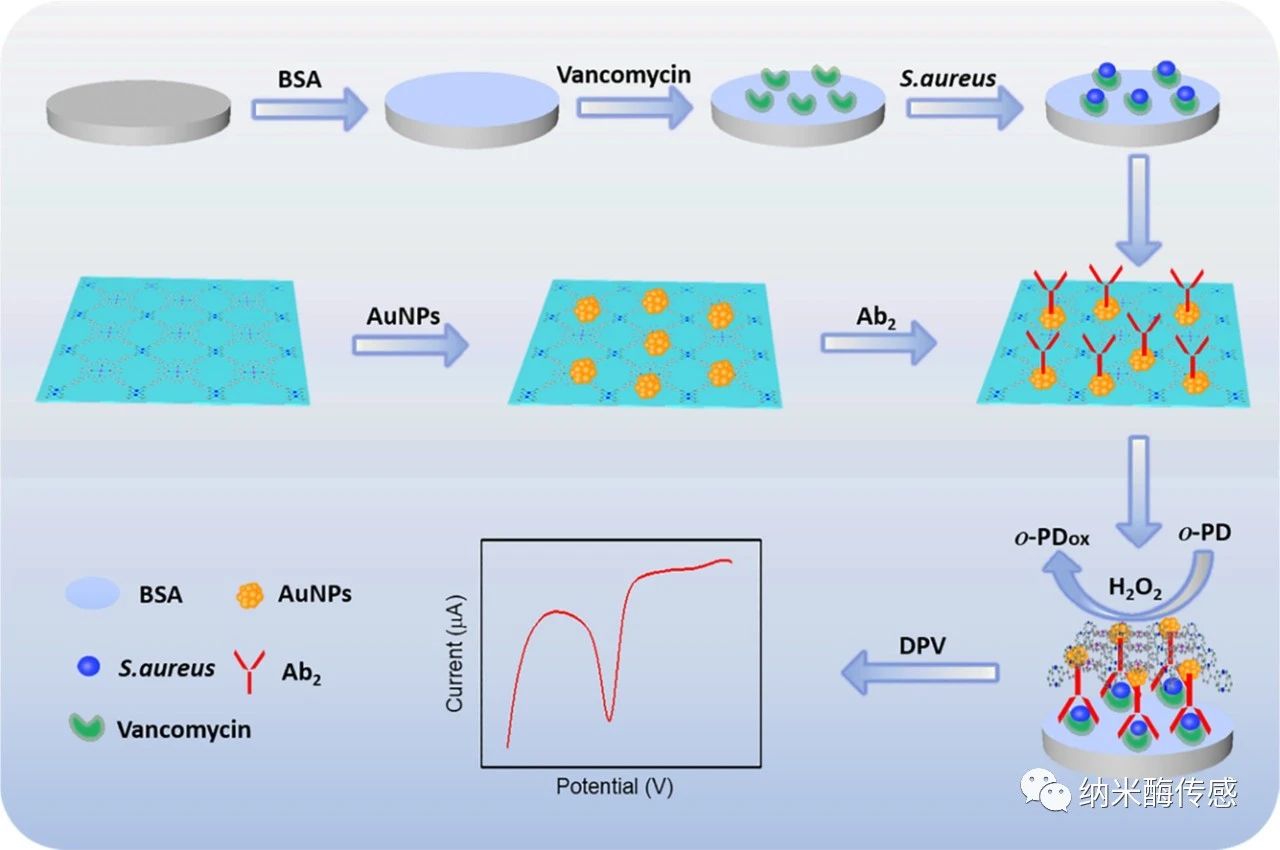[Anal. Chem.] Ultra-sensitive Detection of bacteria by two-dimensional MOF Nano-enzyme magnified Electrochemical detector
QQ Academic Group: 1092348845
Detailed
A brief introduction to the study.
Bacterial infection is one of the leading causes of human death worldwide. In order to prevent the spread of bacterial infectious diseases, it is very important to develop convenient, ultra-sensitive and economical bacterial detection methods.Xia Xinghua of Nanjing University and Wang Chen of Nanjing normal University developed a two-dimensional (2D) metal-organic framework (MOF) electrochemical detector for nanoenzymes and applied it to detect pathogenic Staphylococcus aureus. Staphylococcus aureus was specifically anchored by a dual recognition strategy composed of vancomycin and anti-Staphylococcus aureus antibodies. 2D MOFs with excellent peroxidase-like activity can effectively catalyze o-phenylenediamine to produce 2-diaminoazobenzene, which is an ideal electrochemical signal reader for monitoring bacterial concentration. Under the optimal conditions, the detection range is 10-7.5 ¡Á 107 colony forming unit CFU/mL, and the detection limit is 6 CFU/mL, which is better than that reported in most literature.In addition, the established electrochemical sensor can selectively and accurately identify Staphylococcus aureus in the presence of other bacteria. This study provides a new way for sensitive and selective detection of Staphylococcus aureus and has a broad application prospect in the field of clinical diagnosis.

Figure 1.
Electrochemical detection schematic diagram of Staphylococcus aureus amplified by two-dimensional MOF nano-enzyme. (photo source: Anal. Chem.).
The related results are published in the international academic magazine Analytical Chemistry under the title of Ultrasensitive Detection of Bacteria Using a 2D MOF Nanozyme-Amplified Electrochemical Detector.
Bacterial infection is one of the leading causes of human death worldwide. In order to prevent the spread of bacterial infectious diseases, it is very important to develop convenient, ultra-sensitive and economical bacterial detection methods.Xia Xinghua of Nanjing University and Wang Chen of Nanjing normal University developed a two-dimensional (2D) metal-organic framework (MOF) electrochemical detector for nanoenzymes and applied it to detect pathogenic Staphylococcus aureus. Staphylococcus aureus was specifically anchored by a dual recognition strategy composed of vancomycin and anti-Staphylococcus aureus antibodies. 2D MOFs with excellent peroxidase-like activity can effectively catalyze o-phenylenediamine to produce 2-diaminoazobenzene, which is an ideal electrochemical signal reader for monitoring bacterial concentration. Under the optimal conditions, the detection range is 10-7.5 ¡Á 107 colony forming unit CFU/mL, and the detection limit is 6 CFU/mL, which is better than that reported in most literature.In addition, the established electrochemical sensor can selectively and accurately identify Staphylococcus aureus in the presence of other bacteria. This study provides a new way for sensitive and selective detection of Staphylococcus aureus and has a broad application prospect in the field of clinical diagnosis.

Figure 1.
Electrochemical detection schematic diagram of Staphylococcus aureus amplified by two-dimensional MOF nano-enzyme. (photo source: Anal. Chem.).
The related results are published in the international academic magazine Analytical Chemistry under the title of Ultrasensitive Detection of Bacteria Using a 2D MOF Nanozyme-Amplified Electrochemical Detector.
- Previous£º The latest Review of A
- Next£º A Rising 2D Star: Nove


 Academic Frontier
Academic Frontier